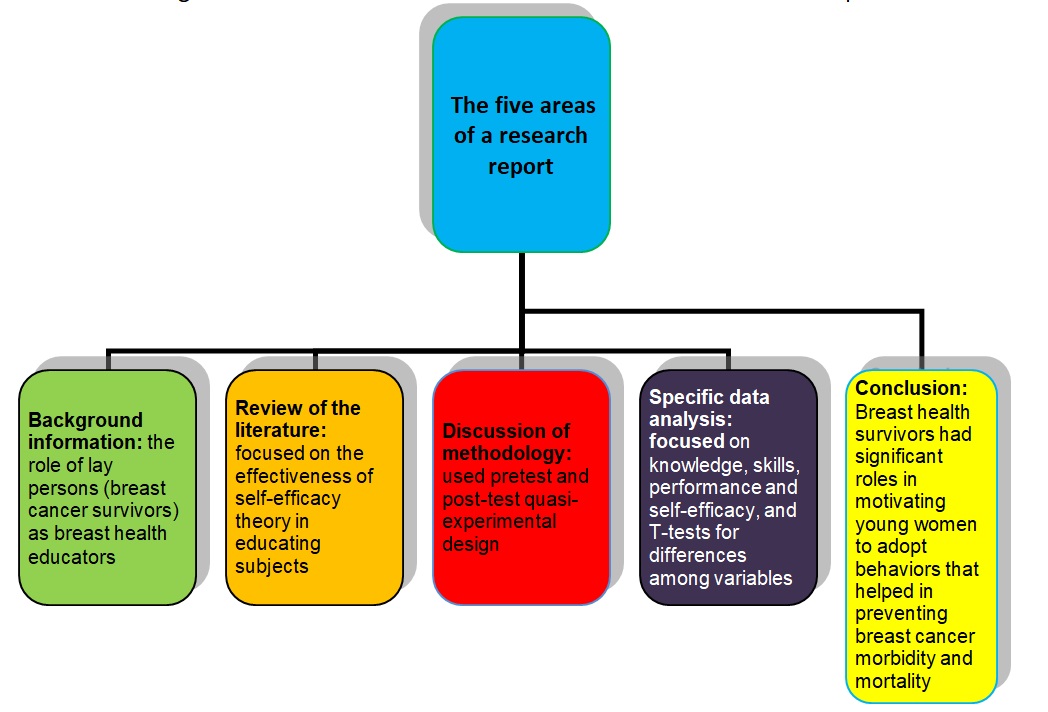A chart showing how the researchers addressed the five areas of a research report.

How evidence of the five areas in the research report supports the conclusion
The conclusion shows that breast health survivors had significant roles in “motivating young women to adopt behaviors that helped in preventing breast cancer morbidity and mortality” (Yi and Park, 2012).
The background of the research shows that past studies have only concentrated on “the role of professionals in providing breast health care education” (Yi and Park, 2012). However, such studies have ignored the role of laypersons (breast cancer survivors). This background observation is consistent with the study’s conclusion.
The review of the literature focuses on “the effectiveness of self-efficacy theory in evidence-based practices” (Yi and Park, 2012). The research also shows that the use of self-efficacy theory is vital in breast health education, as previous studies have shown. These studies include Shin and Choi (1998), Lev (1997), Resnick (2003), and Jung and Tae (2002), among others. This was because it changed behaviors among young women who underwent training by breast cancer survivors.
The methodology used the “pretest and post-test quasi-experimental design to determine the study objective” (Yi and Park, 2012). In conclusion, researchers were able to observe that data collected from subjects were effective for “increasing the breast cancer and breast self-examination knowledge, skills, performance and self-efficacy of young women (Yi and Park, 2012).
The data analysis process aimed at establishing the difference between inclusion and exclusion groups in terms of marital status, age, and education, which researchers identified as factors affecting BSE in Korea. It also accounted for variations in scores among subjects regarding skills, knowledge, performance, and self-efficacy before education and after education. This enabled the researchers to conclude that there were changes in observed behaviors of subjects after education by breast cancer survivors.
The conclusion that breast health survivors had significant roles in “motivating young women to adopt behaviors that helped in preventing breast cancer morbidity” (Yi and Park, 2012) is consistent with the rest of the study areas.
Ethical issues during the research for the article
The researchers and assistants informed the subjects of the aim, methods, benefits, and risks of the study. They also promised confidentiality of the participants. The researchers informed subjects that they could withdraw from the study when they wanted. However, the researchers indicated that many of the trained educators did not take part in the study because they feared the loss of privacy about their medical conditions.
This research tended to avoid the possibilities of ethical issues arising from the study. For instance, the researchers obtained the informed consent of the participants. There was no risk of harm since researchers did not expose participants to any form of medication. There was also the confidentiality of the participants, which guaranteed participants the right to privacy.
The University ethics committee ensured that the study met ethical standards and approved the research to guarantee the safety and rights of the research subjects. This also aimed at protecting the University and the researchers against any possible legal consequences and unethical practices.
The type of research used for the study and whether or not other types of research would have been appropriate in the same situation
The aim of this study was to “examine the effectiveness of breast health education presented to young Korean women by breast cancer survivors about breast cancer and BSE knowledge, skills, performance and self-efficacy” (Yi and Park, 2012).
Therefore, the researchers developed a detailed methodology, which gave it credibility. The study had both pretest and post-test quasi designs to establish reliability and validity of data collected.
Pretest and post-test design allowed the researchers to compare scores among participants in the first, second, and third studies. As a result, the researchers were able to establish the extent of changes occurring due to educational interventions in “knowledge, skills, performance, and self-efficacy among participants” (Yi and Park, 2012).
The research also used participatory action research. The aim of this approach was to generate knowledge and action for direct applications by participants.
There are problems with pretest and post-test research designs regarding external bias. It is difficult to determine whether the design influences study outcomes because other groups lack baseline measurements. It also is difficult to generalize results from this study because pretests may inspire participants to perform well in post-tests.
The researchers can use the Solomon four-group design to overcome challenges from the pretest and post-test quasi design (Spector, 1981). It overcomes cases of internal and external validity. In addition, researchers can generalize the design results to large populations. However, this design is complex and expensive to use.
References
Spector, P. (1981). Research Designs. Thousand Oaks: Sage Publications.
Yi, M. and Park, Y. (2012). Effects of breast health education conducted by trained breast cancer survivors. Journal of Advanced Nursing 68(5), 1100–1110.
